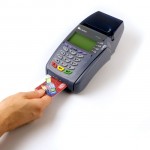A
- ACH transaction: Either a direct deposit or direct payment transaction processed via the Automated Clearing House (ACH). A direct deposit is the deposit of funds for payroll, employee expense reimbursement, government benefits, tax and other refunds, and annuities and interest payments. It includes any ACH credit payment from a business or government to a consumer. A direct payment is either an ACH debit or credit used to make a payment. An ACH debit takes funds from an account; examples include a recurring monthly mortgage payment or utility bill, where the account of the party making the payment is automatically debited by the mortgage company or utility. An ACH credit, on the other hand, is initiated by the party making the payment. An example is where a consumer initiates a payment of a bill through the consumer’s bank or credit union. (See automated clearing house.)
- Acquirer: See acquiring bank.
- Acquiring bank (aka Acquirer): Provides an interface between merchants and the financial institutions (Issuers) that issue credit cards to consumers, who then use them to purchase goods and services from merchants. Acquiring banks 1) originate and maintain merchant accounts for businesses for electronic payments accounting and reporting; 2) process payment transactions for the merchants; and 3) settle them with the Issuers. During settlement, the Issuers pay the funds due the merchants for credit card transactions accepted by the merchants from the Issuers’ customers. The Issuers send the funds to the Acquirer, which places them into the appropriate merchant accounts and then transfers them directly into the merchants’ own bank accounts.
- Address verification service (AVS): Part of the authorization process for eCommerce and other transactions where the cardholder is not face-to-face with the merchant. The street address and zip code entered into an electronic device at the time of sale are verified using data stored in the cardholder’s account with the financial institution that issued the card to the cardholder. Mismatches may indicate that the person initiating the transaction is not the cardholder and that the transaction may be fraudulent. These transactions may be accepted or rejected based on parameters pre-established by the merchant.
- American Bankers Association number (aka ABA number or routing identifier): A nine-digit number appearing at the bottom of a check in addition to the bank account number, which identifies the financial institution holding the bank account.
- ATM: Automated Teller Machine. Devices that displays account balances and dispense cash to cardholders. ATMs held by financial institutions also accept bank account deposits and transfer funds between bank accounts.
- ATM debit card: A multi-purpose card used in conjunction with automated teller machines (ATMs) to access a cardholder’s bank accounts to obtain cash, deposit funds, check account balances, and transfer funds among accounts. ATM debit cards can substitute for credit cards in some POS, on-line, and mobile environments, in which case a PIN may not be required.
- Authorization: Verification during an electronic payment transaction that a valid credit card account or bank account exists and that there are sufficient funds available to cover a purchase amount.
- Authorization code: A response code created when a payment transaction is authorized for processing; it is displayed on transaction receipts. For pre-authorized card payment transactions, the authorization code is required to complete the transaction.
- Authorization fee: The fee amount charged to the merchant when a card payment transaction is authorized.
- “Authorization, Only” transaction: Used to verify the authenticity of a credit card account, and that sufficient funds are available to make a future payment using that account. Funds from the account are set aside in the amount of the future purchase and are unavailable for use by the cardholder for a different purpose. The credit card is charged, and held funds released, when the card payment transaction is completed. For example, this transaction can be used by a home furnishings retailer when a customer orders custom furniture that will be delivered six weeks in the future, which guarantees that the customer will make the payment once the delivery occurs.
- Authorization response: Issued during the authorization phase of a card payment transaction, it indicates if the transaction is approved for processing, declined, or deferred with a request for the merchant to call a toll-free number to provide additional information about the consumer.
- Automated Clearing House (ACH): An electronic network established to exchange electronic payment transactions between participating financial institutions. It supports both direct debit and credit transfer transactions. Its low fees encourage transfer of low-value payments in large quantities. The ACH network is now one of the largest, safest and most reliable payment systems in the world, creating value and enabling innovation for all participants.
- Average transaction amount (aka average ticket amount): Calculated as credit card volume divided by the number of transactions, as reported on a periodic merchant account statement. Typically used as a risk measure when underwriting a new merchant account.
B
- Bank account number: The primary identifier for ownership of a bank account. It is displayed on bank statements and notices, and on the bottom of checks along with a routing identifier to indicate the specific financial institution and account.
- Basis point: Typically used in finance to describe rates, one basis point equals 1/100 of one percent. Merchant account rates, for example, might be described as Interchange plus 55 basis points, meaning that the merchant will be charged the Interchange rate, authorization fee, dues, and assessments charged by Visa, MasterCard, et al, plus .55% for processor operating costs.
- Batch: A collection of individual card payment transactions in one data file; for example, a merchant’s transactions accumulated during a single day by an Internet payments gateway, point-of-sale system, or credit card terminal.
- Batch processing: Closing or settling a complete batch of transactions together.
- Breach security coverage: Insurance coverage in the event of a data breach.
- Business type: A merchant account business classification. Business type categories are: retail, restaurant, hotel, mail order / telephone order (MOTO), and Internet. The mail order / telephone order category includes all those orders submitted remotely that require key entry into an actual or virtual credit card terminal, including orders received via e-mail and fax. The Internet category refers to eCommerce, including payments via web-sites, and via mobile devices like cell phones and tablets.
- Business-to-business (B2B): The sale of products and services by a business to other businesses, rather than to consumers.
C
- Card brand (aka payment brand): The name, term, design, symbol, or any other feature used in business, marketing, and advertising, that distinguishes card associations like Visa, MasterCard, American Express, Discover, UnionPay, and JCB from one another.
- Card networks (see also card associations): Electronic networks maintained by the card associations that inter-relate member card issuers and merchant acquirers for payment card transaction authorization, clearing, and settlement. The four major networks are maintained by Visa, MasterCard, American Express, and Discover.
- Card transaction settlement: A process by which financial institutions (Issuers) that have issued credit cards to consumers reimburse merchants for the value of transactions involving the use of those cards to purchase goods and services.
- Card-not-present (CNP) transaction: Payment card transaction in which the cardholder is not physically present with the merchant. On-line, mobile, mail (and e-mail), and telephone orders are examples of card-not-present transactions.
- Card-present (CP) transaction: Payment card transaction in which the cardholder has possession of the card and presents it, face-to-face, to the merchant. This transaction type has lower risk than a card-not-present transaction, because further identification can be requested by the merchant, if necessary.
- Card reader: Device used to read credit card information from a payment card, including EMV files, while processing a credit card transaction.
- Cash-flow: The net amount of cash and cash-equivalents being transferred into and out of a business. Accepting electronic payments in the retail environment increases cash-flow, by increasing the number of acceptable transactions and processing them faster. For instance, denying customers who wish to pay by check reduces potential cash flow by reducing the number of transactions. In the business-to-business (B2B) environment, cash-flow can accelerate by reducing the time between invoicing a client and receiving payment.
- Charge card: Payment card for which transactions are billed to the cardholder’s account; requiring the account balance to be repaid in full each month.
- Chargeback: Procedure for disputing a credit card transaction. It includes the following elements: 1) a customer contacts the financial institution that issued the customer’s credit card, known as the card Issuer, and disputes a credit card transaction on the basis of either fraudulent use of the card by another, non-receipt of merchandise, improper shipment, defective merchandise, etc.; 2) the card Issuer questions the customer, prepares a document indicating why the customer believes that a refund in the amount of the original payment transaction is due the cardholder, and demands the refund from the merchant, via the Acquirer; 3) the disputed funds are withdrawn by the credit card processor from the merchant’s merchant account or bank account until the dispute is resolved; 4) the merchant responds to a request from the Acquirer for information, typically providing a sales receipt, proof of delivery of merchandise, a purchase order, an invoice, and other relevant documentation as may be available about the original transaction; 5) all documentation is reviewed by the relevant card brand or its designated representative and the chargeback claim is approved or denied. Either party may appeal the decision. A customer typically has about six months from the date a customer and merchant last communicated about a transaction, in which to file a chargeback complaint.
- Chargeback dispute resolution manager: An automated system which reduces time to process card payment chargeback claims by allowing the merchant to download chargeback notices and upload appropriate transaction documentation on-line. The system is used in conjunction with e-mail notification that a chargeback has been initiated by a customer in relation to a disputed credit card payment. (See Chargeback.)
- Chip and PIN technology: POS credit card acceptance requiring 1) cards containing EMV chips and 2) PIN data entry by the consumer. (See EMV card and personal identification number.)
- Clearing: Determining accountability for the exchange of funds and financial assets among the parties to a financial transaction. Specifically, collected credit card transaction data is typically provided each business day by merchants to their credit card processing companies for processing. The credit card processors forward the transaction data via the card association networks to the financial institutions (Issuers) that originally issued the credit cards involved to the merchant’s customers. Clearing concerns verifying the accuracy of the transaction data before settlement occurs. (See card transaction settlement.)
- Co-branded credit card: Credit card sponsored by two parties. Typically one is a retailer, such as a department store, gasoline retailer, or airline, and the other is a financial institution or card network such as Visa, MasterCard, Discover or American Express.
- Consumer: A person or business that purchases goods and services for use.
- Credit card: A payment card issued by a financial institution (Issuer) to its customers, which allows the customers in turn to purchase products and services on credit. Credit card transactions are billed to the cardholder in monthly installments, and the billed amount is dependent upon the current account balance; as distinct from charge cards which require payment of the balance in full each month.
- Credit card association: A card brand that sets common transaction terms, and regulates card issuance and acceptance for merchants, issuers, and acquirers. Major associations include Visa, MasterCard, American Express, and Discover.
- Credit card fraud: Unauthorized, illegal use of a credit card to either obtain goods and services without actually paying for them, or to obtain funds from a credit card account by way of a cash advance. Frequently, credit card fraud is part of a broader theft of someone’s identity, which is then used to obtain new credit cards, new loans, and new lines of credit. Factors relating to credit card fraud include stolen cards, ID theft, dishonest employees who copy credit card information, telemarketing scams, skimming, and phishing. Many credit card companies will not hold the defrauded party liable for fraudulent charges, or will charge a relatively small fee.
- Credit card network: The purpose of a credit card network is to control where credit cards can be accepted and to facilitate card payment transactions between merchants and consumers. It sets the interchange fees charged to merchants that accept credit card transactions, yet does not control fees a cardholder pays for using credit cards; such as interest rates, annual fees, late fees, foreign transaction fees, and over-limit fees. The four main credit card networks are operated by Visa, MasterCard, American Express and Discover.
- Credit card processor: The financial institution that facilitates verification, authorization, clearing, and settlement of credit card transactions for its merchants.
- Credit card volume (aka purchase volume): Total dollar amount of card payments; typically calculated monthly or weekly, depending on the total amount for a given period of time. It is displayed within the merchant’s credit card processing statement.
- Credit transfer: ACH non-immediate transfer of funds between accounts located within the same or different financial institutions, for payments by retail customers and for non-urgent business-to-business payments.
- Cryptocurrency wallet: A device, physical medium, program, or service which stores public and private electronic keys allowing access to the wallet. It is used to track cryptocurrency ownership and to receive and spend cryptocurrencies stored in a blockchain, which is a publicly available distributed ledger.
- Customer: An individual or firm purchasing goods and services from a merchant.
D
- Data capture: Use of an electronic device to acquire the data necessary to process a card payment transaction, and the data’s subsequent transmission for transaction processing and settlement.
- Data encryption: Translation of digital data into electronic code to ensure secured data transmission and storage.
- Data security: Protection of digital data from physical corruption of devices and data files, and from unauthorized data access.
- Debit card: A payment card issued by a financial institution to its customer, allowing the customer to purchase products and services using the customer’s bank account.
- Digital wallet (aka eWallet): Electronic storage of digital card data used to purchase goods and services. For instance, when eWallets are stored within smartphones, the devices can be used in conjunction with NFC-capable POS devices to make payments. Personal credentials and other information can also be stored in eWallets, and current uses include determining whether someone is of legal age to purchase alcohol and tobacco.
- Direct debit: See ACH transactions.
- Direct deposit: See ACH transactions.
- Discount rate: Charged to a merchant for debit and credit card payment processing services rendered. It is a set percentage of the dollar amount of each transaction, covering a processor’s operating expenses and including Interchange fees and dues and assessments charged by the card brands. The merchant agrees to the rate prior to accepting credit card and debit card payments from customers.
- Dues and assessments: Fees paid directly to the Card Associations by merchants, for their use of the card brands to attract customers, and the right to process credit and debit card transactions using Visa, MasterCard, American Express, and Discover payment networks.
E
- EBT card: See electronic benefits transfer.
- eCheck: See electronic check.
- eCommerce: Commercial transactions conducted electronically, using the Internet; which is primarily accessed via smartphones, laptops, and PCs vis-à-vis these transactions.
- eCommerce payment: An on-line payment widely used for Internet-based shopping and banking.
- eCommerce shopping cart: An automated service allowing merchants to sell products and services on-line. The merchant can build an on-line store; including product catalog with descriptions, images, and pricing. Shopping carts integrate with Internet payment gateways to provide to customers the convenience of immediately paying on-line for selected catalog items, and applicable taxes and shipment charges.
- Electronic benefits transfer (EBT): An electronic system used by state governments to provide financial and material benefits to welfare recipients via pre-funded debit card; including unemployment and food benefits. EBT cards are accepted by merchants and processed via point-of-sale systems and credit card terminals.
- Electronic check (aka eCheck): An electronic payment method which replaces a conventional paper check and offers simplified transaction processing. A consumer can purchase a product on-line and provide the associated bank routing identification number and specific bank account number to be debited as payment.
- Electronic funds transfer (EFT): An electronic transfer of funds from one bank account to another, either within a single financial institution or between one and another.
- Electronic payment (aka ePayment): Payment for purchased goods and services made by credit card, debit card, or bank transfer involving electronic transmission of payments data; it also can refer to peer-to-peer payments. Examples include purchases using the Internet, POS systems, credit card terminals, computers, electronic tablets, and smartphones. Additional electronic payment tools include electronic wallets and cryptocurrency wallets.
- Electronic payments gateway: Commonly a third-party interface handling transmission of transaction data between a merchant and its processor. Gateways commonly provide additional features, too, such as a search feature, transaction reporting, customer relationship management (CRM), and data security protection. Gateways integrate with eCommerce web-site shopping carts, mobile devices such as smartphones and electronic tablets, and various retail point-of-sale systems.
- Electronic wallet (aka eWallet): Securely encrypted and convenient digital storage of payment card information within, for example, a smart phone. It replaces actual credit cards and debit cards and is used to perform electronic payment transactions in conjunction with devices that accept contactless payments using NFC technology.
- EMV: An acronym for an organization comprised of EuroPay, MasterCard, and Visa, which developed a global standard for smart payment cards.
- EMV card: A smart payment card containing a computer chip and technology used to authenticate chip-card transactions. It is designed to protect consumers by reducing fraudulent use of credit and debit cards.
- eWallet: See digital wallet.
F
- Fraud prevention service: Reduces fraudulent transactions and associated charge-back claims using big data, artificial intelligence, machine learning, predictive analytics, and innovative prevention systems to determine the probability that each presented transaction may be fraudulent. As a result, more transactions are automatically approved in real time and more of the likely fraudulent transactions are declined or diverted for manual review.
I
- Interchange: The process in which an Acquirer or Acquiring bank submits approved card payment transactions data to Issuers and Issuing banks for payment, on behalf of its merchants.
- Interchange fee: A fee set by the payment card brands and paid to associated card-issuing financial institutions (Issuers) to cover costs of offering lines of credit and fraud mitigation to consumers.
- Internet payments gateway: An automated system which can connect an eCommerce application with a credit card processor and typically offers a virtual terminal for back-office transaction processing, as well. It authorizes payment transactions, transmits transaction data to the processor for clearing and settlement, and provides sophisticated transaction reporting to merchants. Some gateways also offer ACH transaction processing, customer relationship management, fraud detection, electronic invoicing, and related services.
- Invoice: A commercial document issued by a seller to a buyer, which itemizes products, quantities, and agreed prices for products or services sold.
- Invoice payment: Full or partial payment on account for products and services a seller has provided to a buyer.
- Issuer (aka Issuing bank): A bank or financial institution that is a licensed member of a brand’s credit card network. It provides credit card holders with credit to purchase goods and services from merchants, and to obtain cash advances. Its functions include: 1) approving or denying credit card applications, 2) setting credit card account terms, 3) paying merchants for approved transactions via the merchant’s acquiring financial institution, 4) collecting credit card account payments from cardholders, and 5) providing customer service.
L
- Level I card data: Captured vis-à-vis consumer credit card processing.
- Level II enhanced data: Captured vis-à-vis B2B credit card transactions involving small-sized and medium-sized enterprises (SMEs). Sellers benefit from a reduced interchange fee, and therefore increased profits.
- Level III enhanced data: Captured vis-à-vis large corporate and government purchases. It includes Level II enhanced data capture, plus additional data capture of line item details such as product codes, descriptions, quantities, and unit costs. Merchants capturing line item data receive a significant Interchange rate discount, and transaction reporting is available to the company purchasing goods and services, for expense control.
M
- Major card brands: Visa, MasterCard, American Express, Discover, UnionPay, and JCB.
- Merchant: A business that sells products and services to consumers.
- Merchant account: A commercial bank account established by an Acquirer for a merchant, specifically used to process credit card and debit card payments. It also connotes the business arrangement between a merchant and a credit card processor that allows the merchant to accept payment cards from its customers.
- Merchant account underwriting: Assumption of ultimate risk and acceptance of liability by an Acquirer on behalf of its merchants. The Acquirer guarantees payments for those specific claims against merchants that merchants fail to satisfy.
- Merchant
services: A broad
category of financial services intended for use by businesses. In
many cases it refers more specifically to electronic payment processing
services, including:
- Automated Clearing House payment services and check drafting
- Retail point-of-sale (POS) systems
- Check guarantee and check conversion services
- Electronic benefits transfer programs (food stamps)
- Merchant services provider: Provider of payment card processing and related services. It is an intermediary between merchants, issuing banks, and credit card networks. (See merchant services.)
- Merchant processing agreement (MPA): The contract between your merchant account provider and you that outlines the responsibilities and warranties of all parties involved in credit card processing.
- Mobile credit card processing: Processing payment card transactions that were created using a mobile device; such as a wireless terminal, smartphone, or electronic tablet.
- Monthly minimum fee: The amount that a processor charges the merchant if its discount rate, transaction fees, and other account fees total less than a pre-established amount defined in a merchant processing agreement (MPA). For instance, if the monthly minimum fee amount is $25.00 per month and the accrued fees for a monthly period total $17.00, the account will be charged $25.00.
- Mobile payments acceptance: A mobile app is downloaded to an electronic smartphone or electronic tablet, or a wireless credit card terminal is used. The devices can accept electronic payments when the merchant is on the road, and when the merchant is trying to better handle a long customer line at a cashier’s counter during rush hour in a cafeteria or convenience store, by accepting payments in the middle of the line.
- Monthly processing limit: The total dollar amount of monthly charge transactions a merchant service provider will allow a merchant to process before incurring additional fees, as defined in the merchant’s merchant processing agreement.
- Monthly processing volume: The total dollar amount of periodic transactions processed during a period of one month, as reported on a monthly processing statement. In relation to a merchant processing application form, this is the merchant’s estimated total dollar amount of monthly electronic payments, including credit card and debit card transactions. It is used in conjunction with an estimated average ticket size to help the merchant services provider determine a merchant’s level of risk during the underwriting process.
- MOTO: Acronym originally indicating a mail order or telephone order transaction. It now includes other card-not-present transaction types, such as orders received via e-mail and text messaging.
N
- Near-field communication (NFC): A set of communication protocols enabling two electronic devices to establish communication by bringing them within 4 cm of each other. For example, devices with NFC capability accept smartphone payments.
O
- On-line payment: See eCommerce payment.
- Over-limit fee: A fee charged by a merchant services provider to a merchant when a monthly credit card volume limit has been exceeded.
P
- Payment card: Denoting a credit, debit, prepaid, EBT, or ATM card.
- Payment card industry data security standards (PCI-DSS): A set of requirements established by the credit card networks to protect confidential cardholder data and reduce the risk of data theft and the associated fraudulent use of cardholder identities. The standards apply to all merchants, merchant account providers, issuing banks, and credit card networks.
- PCI compliance: Merchant compliance with payment card industry data security standards (aka PCI/DSS). Requirements may include an annual self-assessment questionnaire (SAQ), a quarterly network scan for firms that electronically store cardholder information or maintain application systems connected to the Internet, and on-site compliance investigations for larger firms.
- PCI compliance validation certificate: Obtained by fulfilling applicable payment card industry data security standards requirements. See PCI compliance.
- Payment method: An acceptable way that a buyer compensates a seller of goods and services. Typical payment methods used in business transactions include cash, checks, credit cards, debit cards, money orders, ACH direct payments, and wire transfers. Cryptocurrency transfers are accepted by some major retailers and are also used for processing cross-border payments, to improve relative transaction processing speed and to reduce transaction costs.
- PCI non-validation fee: A monthly fee charged to merchants that have failed 1) to comply with payment card industry data security standards in a timely manner, or 2) to provide a PCI compliance validation certificate.
- Peer-to-peer (P2P) payment: Transaction generally involving a payment between one individual and another, including paying rent, sending money to friends and relatives, and splitting a restaurant tab; the latter can involve more than two people. An individual sets up a peer-to-peer account and links either a bank account or credit card. Transactions can be initiated via computer or mobile device.
- Personal identification number (PIN): A unique number selected by the consumer to be entered into a PIN pad vis-à-vis electronic payment transactions occurring at the point-of–sale. Its purpose is to reduce unauthorized use of payment cards. In the United States it is used predominantly for debit cards. In areas outside the United States such as Europe, chip (EMV) and PIN technology is used for most POS credit card payments, as well. Passwords are gradually being replaced in the United States; taking advantage of more secure, evolving technologies.
- PIN pad: Keypad used by a PIN debit card holder to enter a PIN at the Point-of-Sale.
- Point-of-sale (POS): The point-of-sale, also known as the point-of-purchase, is where a retail face-to-face transaction is completed. In a retail store, it is the location of a point-of-sale system, or perhaps a credit card terminal, mobile terminal, wireless terminal, or virtual terminal. At the point of sale, the merchant calculates the amount owed by the customer, accepts offered payments, and provides a sales receipt. For some transactions, an invoice may be prepared for payment at the present moment or for a future payment.
- Point-of-sale system: An electronic cash register system that can process payments, track inventory, market to customers, schedule employees, facilitate payroll accounting, and much more. Benefits to the merchant include offering customer convenience, simplifying processes, and reducing transaction time and paper flow.
- Point-of-sale terminal: An electronic device used to capture, transmit and receive electronic payment information. A name used to describe 1) the cash register hardware of a point-of-sale system, and 2) the typical credit card terminal.
- POS: Acronym for point-of-sale.
- POS system: See point-of-sale system.
- POS terminal: See point-of-sale terminal.
- Prepaid card: A debit card pre-funded by or for a cardholder. It can serve as a budgeting tool or as a replacement for a bank account. A prepaid card can offer convenience with few fees and is easy to obtain. It is also used to store payments; for example, replacing payroll and benefit transfer checks. Prepaid gift cards are prevalent in abundance wherever people shop.
R `
- Real-time processing: Processing that occurs when a transaction is initiated; for instance, approving or declining a payment card transaction in seconds while the customer waits.
- Recurring payments: Payments for products and services that are charged to a customer’s card account on a regularly scheduled basis; such as weekly, monthly, or annually. Web-hosting, club memberships, managed services, and other subscription services are examples of services billed on a recurring basis.
- Retail payment: Payment transaction between merchants and consumers, or between small-to-medium sized businesses. Retail business-to-business transactions are usually at a higher volume and lower average ticket amount than those categorized as wholesale payments.
- Retrieval: The first step in the chargeback process. When a credit card transaction is disputed, the issuing bank requests a copy of the associated sales receipt and other transaction documentation from the merchant.
S
- Shopping cart: See eCommerce shopping cart.
- Smart card: See EMV.
T
- Transaction volume: Total dollar amount of a group of transactions.
- Transit routing identifier: See American Bankers Association (ABA) number.
- Transport layer security (TLS): A cryptographic protocol that provides end-to-end communications security over networks and is widely used for Internet communications and on-line transactions. It is an IETF standard intended to prevent eavesdropping, tampering and message forgery.
- Terminated merchant file (TMF): Also known as a match file, this database is maintained by third-party processors, banks and other financial institutions and lists the names of merchants for which privileges to process credit cards and other electronic transactions have been terminated by an Acquirer for significant violation of a merchant processing agreement.
- Tokenization: Substitution of sensitive cardholder data elements located within data processing and application systems, using non-sensitive equivalents referred to as tokens. The sensitive data is securely stored, externally. For example, a card number and card expiration date would be replaced by tokens and the sensitive data might be stored off-site in a secure location.. Tokens reference and identify the externally stored sensitive data using a tokenization system, and it is infeasible to create or reverse the tokens except with its use.
U
- Underwriting: See merchant account underwriting.
V
- Virtual card: A virtual card allows you to minimize the amount of personally identifiable information during an electronic payment transaction. It is a randomly-generated card number associated with your actual credit card for one-time use. Depending on the issuer, you may be able to set a maximum charge amount for the virtual number, further protecting your transaction. Typically, you can set it to expire any time up to a year from its creation date.
- Virtual credit card: See virtual card.
- Virtual terminal: An on-line version of a credit card terminal which operates in conjunction with an Internet payments gateway; it can be accessed using any Internet web browser. It is used to enter and process electronic payment transactions and to access gateway search, reporting, and settlement initiation capabilities.
- Volume: See credit card volume.
W
- Wholesale payments: Payment transactions between large corporate firms; usually having a higher average ticket amount and lower total number of transactions than that found with SME business-to-business transactions. Wholesale business-to-business firms process back-office invoice payments using virtual or physical payment card terminals, and may have warehouse outlets utilizing retail POS systems to accept card payments. Some might have their own delivery vehicles and accept COD payments using mobile card acceptance devices. These firms traditionally favor ACH bank transfer payments to card payments, yet are moving toward accepting more virtual cards that help their customers control expenses. They are also moving toward accepting traditional card payments that help themselves to improve cash flow by reducing the time involved in receiving invoice payments, and by reducing transaction costs.
- Wire transfer (aka a bank wire): An electronic transfer of money, which typically processes from one financial institution to another using either the SWIFT or Fedwire network. It is favored when the recipient wants assurance that the funds will be immediately available; such as when a home purchase is made and a buyer is transferring funds into escrow for a down payment on a mortgage.



 PHOTO BY: Ken Teegardin
PHOTO BY: Ken Teegardin PHOTO CREDIT: Pixabay
PHOTO CREDIT: Pixabay PHOTO CREDIT: Pixabay
PHOTO CREDIT: Pixabay PHOTO CREDIT: Creative Commons
PHOTO CREDIT: Creative Commons The underwriter will ensure that Internet merchants provide required disclosures for customers, which may include:
The underwriter will ensure that Internet merchants provide required disclosures for customers, which may include:








